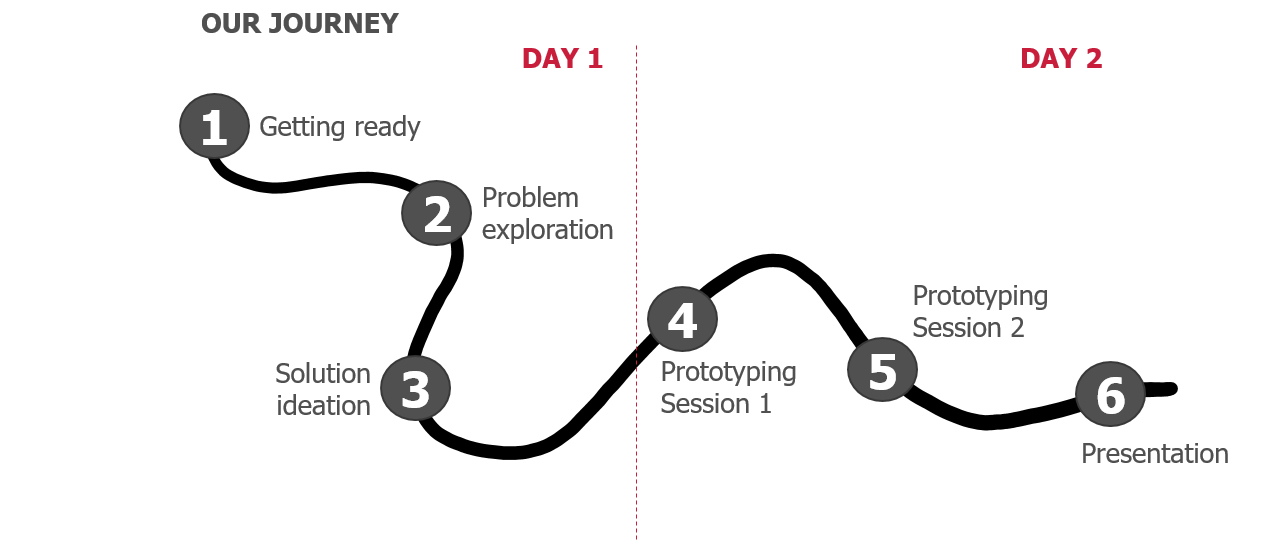About a year ago, we at MDI held our first internal Hackathon event and immediately shared our experience with this method.
A lot of time has passed since then. A time that made us and our environment rethink the future of work even faster than we had already planned. Large events, which usually require to gather all people into one room, like a hackathon does, are not possible under today’s conditions. This does not mean, however, that strategically relevant issues, which should be dealt with in a timely and agile manner with the involvement of as many stakeholders as possible, should pause.
Hackathons create an exciting atmosphere for virtual collaboration without boundaries. With this article we show you “How to Hackathon”!

About the author
Elisabeth Oppenauer, also lovingly called Elli by the team, consultant and team lead at MDI, talks today about her experiences and insights in the leadership & development area. Her journey at MDI began as a junior consultant and her passion quickly led her to growing into the team and HR management.
Together with our customer we therefore designed an initially hybrid and then virtual concept (new COVID regulations) of an international hackathon for the Learning & Development sector.
More than 60 participants from all continents and almost all internally represented business functions were invited to the international hackathon in early September. MDI supported the Corporate HR team in the conception of this event. How? Find out here:
Step 1: Define the question
In advance, the general questions have to be answered:
- What in particular should be worked on?
- What is the purpose of the question?
- What is the aim of the event?
- Why exactly this format = Hackathon?
- What happens with the results of the event?
Present questions, which are important at the beginning of the event, to the plenum in order to convince them of the sense of the matter.
Step 2: Division of the groups
For virtual large group formats, we recommend that you divide the groups in advance due to the time resources available. The energy and attention level or their tolerance limit is much lower in virtual space. Thus the focus was put on the following essential characteristics:
- Maximum 6 participants per group
- 1 Digital Native per group
- Diversity (gender, nationality, function, etc.)
Step 3: Design of the (virtual) framework
A hackathon is a creative, entertaining and cross-functional form of solution development and originates from the Sillicon Valley. They differ from conventional brainstorming formats mainly in the spirit that a well executed hackathon brings, but also in the process itself.
Hackathons create an exciting and challenging atmosphere with an out-of-the-box feeling. Usually everyone can come dressed as they like. The focus is on: well-being.
The Hackathon lives from a rather hectic but also communal atmosphere. An atmosphere that can be created on site by the design of the premises, or by ordering pizzas together, or listening to music in the background.

In a virtual set-up the general conditions are more limited but not impossible!
So we were able to start with a virtual preparation task, which asked the participants to leave their superhero power (personal strength) on a prefabricated whiteboard (used tool: MIRO) with their name.
Advantage: the participants have to familiarize themselves with the virtual tool for the first time and they find funny sticker notes of other colleagues on the board, which in turn strengthens the positive mood and interest in the event.
Furthermore, the participants received a virtual flyer in advance, which informed them about technical conditions and invited them to participate:
- to take their “Favourite Mug” with them
- to put on your absolute favorite sweater/ hoodie (- theme: “be as casual as possible”) and
- set a virtual background of your home town (ideally: personal photo)
The last point was a great opportunity for exchange, especially during the warm up phase of the event. Automatically, the participants asked each other where and when this photo was taken. Storytelling begins ?
Step 4: Ready to Hack – Part 1
After the WHAT, WHY and HOW has been presented and the virtual tool has been introduced in detail by the facilitator, the actual hackathon process begins. This was divided into 2 half days due to the different time zones and the attention of the participants and it looked as follows:

Ready to Hack begins with:
Point 2 – Problem Exploration
The participants were asked to work out the main challenges of the company in relation to the above-mentioned question, to discuss them in their respective groups and to outline them on a virtual whiteboard. This whiteboard was prepared in advance by our team of trainers using professional templates. The teams only had to zoom into their respective MIRO board.
Time frame: 45 minutes
Afterwards, they all meet again together in the plenum session. A short energizer and health check by the facilitator follows.
Point 3: Solution Ideation
Based on the results of point 2 “Problem Exploration” the participants are then asked to develop potential ideas, solutions, measures and activities. Again, some principles to be followed are presented before the groups move into their breakout sessions.
Time frame: 45 minutes
This is followed by a wrap-up, which evaluates the success of day 1 and provides an outlook for day 2. At the end of day 1, the MDI team and the Corporate HR team summarized the most important results and defined topics to be worked on on day 2. In this case, 6 different topics crystallized out, which were presented to the participants on day 2.
Step 5: Ready to Hack – Part 2
Independent of the predefined group divisions on day 1, the participants on day 2 were allowed to decide for themselves on which topics they would like to continue working (e.g.: job rotation, onboarding, learning culture, etc.) depending on their personal background, interest, expertise and function. One can speak of a so-called Bar Camp Style.
The added value:
- Intrinsic motivation is strengthened
- Expertise can be used
- Repeated mixing and getting to know each other
The main difference from day 1 to day 2 is the altitude. While on day 1, the participants were flying at a very high altitude. On day 2, they were invited to create concrete “prototypes” of their ideas in 2 sessions of 45 minutes each. At the end of the day, the results were presented in the plenum and feedback was collected from the colleagues.
The output of the event was numerous ideas and also concrete solutions, which were developed by the participants with a high level of energy and commitment. As a follow-up/summary of all results is very important in such a format, the participants were invited to a follow-up Deep Dive Hackathon 2 weeks later.
Aim of the follow-up event:
Corporate HR summarized the results of the Hackathon teams and presented the results, how and in which form they will continue to work and argued in detail why others are currently not being worked on. In this case it is important to visualize all the topics that have been worked on and to discuss why they cannot be continued for various reasons. The focus in this case was on the Quick Wins. The participants were asked one last time to assign themselves to a topic and define a final input and measures based on the results of the last round.
What made this Deep Dive Session so valuable?
- It allowed the final polishing of individual actions
- Further feedback from other participants – Spektrum Diversity
- Field: “Who wants to work further on this idea” – at the end, all were invited to get further involved in topics on a voluntary basis
- Internal ambassadors for the topics were automatically created, which positively promote and advance the topics
All in all, it was fun for our team to provide advice and support and to experience the dynamics of the event at first hand!
And because we like to let our participants speak, we would like to share a few comments with you:
- Wow great experience“
- “Need to do this more often – opens mind and discussions”
- “We should do more WS like this one”
- “Feels good to address certain point with people who have same views to improve”
- “Nice way of working – great collaboration and team spirit”
- This is a huge step to improve our company culture
- Exceeded my expectations
- We definitely need more of that
- Hope we will use this format in the future to improve the company even more
- Thank you for doing this! Great initiative and new approach with great tools in the new-normal. I am supporting the transfer of the ideas into real actions for the benefit of the business and all of us!
- Should really use Hackathon for future challenges … GREAT

